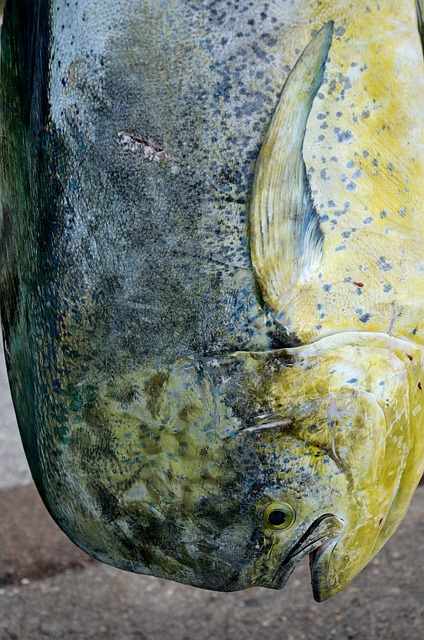Most of the information on this website is specifically about making jerky. But sometimes, there are interesting facts about a certain animal, in this case, a type of fish, Mahi-Mahi, that I wanted to share.
Mahi-mahi, also known as dolphinfish or dorado, is a species of fish found in warm oceanic waters.
Despite its common name, mahi-mahi is not related to dolphins. The name “dolphinfish” often leads to confusion, but mahi-mahi is a type of fish, not a mammal.
Side note… As I was researching this information for this article, I never realized that “dorado” was the same as mahi-mahi. Dorado is the name of a fish that is common in Brazil, where I lived for 10 years. I have been back from Brazil for many years, and I’m still learning new things!
Mahi-mahi is known for its vibrant and striking colors. The body can range from bright green and blue to gold and yellow. They often have a distinctive pattern of spots and stripes. See the picture below for one type.
Mahi-mahis are generally medium to large-sized fish. They can reach lengths of up to 6 feet (1.8 meters) or more, although the average size is around 3 feet (0.9 meters). They have a slender, streamlined body with a long dorsal fin that extends along the back. The anal fin is also elongated.
Mahi-mahi are found in warm waters, typically in tropical and subtropical regions. They prefer temperatures between 70 to 80°F (21 to 27°C). Mahi-mahi is found in the Atlantic, Indian, and Pacific Oceans. They are often associated with offshore waters and are commonly found near floating debris, seaweed, or other structures.
They are carnivorous and feed on a diet of small fish, squid, and crustaceans.
The flesh of mahi-mahi is firm, white, and mild-tasting. It has a slightly sweet flavor and is versatile in the kitchen. Mahi-mahi can be grilled, baked, or pan-seared. It is also a common choice for making fish tacos. And we can’t leave out it’s great for making homemade jerky.
Mahi-mahi is generally considered a sustainable seafood option, as it has a relatively high reproduction rate and is not subject to overfishing in most regions.
Mahi-mahi are known for their speed and agility in the water. They can swim at speeds of up to 50 miles per hour (80 kilometers per hour).
In the wild, mahi-mahi typically have a lifespan of about 4 to 5 years.

Image by Rene Ambrusch
The Golden Dorado (Salminus maxillosus or Salminus brasiliensis) is a large river fish that is found in South America. Above, we talked about ocean fish, where which live in freshwater. They are native to the waters found in Argentina, Bolivia, Brazil, Paraguay, and Uruguay.
The Dorado is also Argentina’s national fish. It is also a very popular sport fish around the globe—anglers really like the challenge of its fighting ability as well as the meat itself.
Mahi-mahi is a popular target for sport fishing due to its size, striking appearance, and acrobatic behavior when hooked. So, fishermen, get your rods ready!
Mahi-mahi is a popular fish in both recreational and commercial fishing, appreciated for its vibrant appearance and delicious taste. Its versatility in the kitchen makes it a favorite choice among seafood enthusiasts.
Now it’s time to make some jerky. Check out the first link below for some Mahi-mahi recipes for jerky.
Links That May Interest You
Mahi-Mahi Recipes for Jerky
Fish Jerky Basics – From types of fish to texture of fish jerky. This has good insights into making fish jerky.
Ingredients For Fish Jerky – How different ingredients affect the flavor of your fish jerky.
Fish Jerky Recipes – many species of fish can be used to make jerky, but not all.
